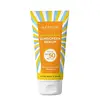What's inside
What's inside
 Key Ingredients
Key Ingredients

 Benefits
Benefits

 Concerns
Concerns

 Ingredients Side-by-side
Ingredients Side-by-side

Water
Skin ConditioningCyclohexasiloxane
EmollientEthylhexyl Methoxycinnamate
UV AbsorberSilica
AbrasiveEthylhexyl Salicylate
UV AbsorberGlycerin
HumectantTitanium Dioxide
Cosmetic ColorantPEG-10 Dimethicone
Skin ConditioningCaprylyl Methicone
Skin ConditioningZinc Oxide
Cosmetic ColorantPolymethyl Methacrylate
Pentylene Glycol
Skin ConditioningGlyceryl Glucoside
HumectantPachyrhizus Erosus Root Extract
Skin Conditioning1,2-Hexanediol
Skin ConditioningCetyl PEG/PPG-10/1 Dimethicone
EmulsifyingMagnesium Sulfate
CI 77007
Cosmetic ColorantAllantoin
Skin ConditioningTrimethylsiloxysilicate
EmollientAluminum Hydroxide
EmollientStearic Acid
CleansingHydroxyacetophenone
AntioxidantOctyldodecanol
EmollientDisteardimonium Hectorite
StabilisingButylene Glycol
HumectantGlyceryl Caprylate
EmollientDipotassium Glycyrrhizate
HumectantDimethicone
EmollientHelianthus Annuus Seed Oil
EmollientPropanediol
SolventSodium Phytate
Triethoxycaprylylsilane
Methyl Diisopropyl Propionamide
MaskingPolyhydroxystearic Acid
EmulsifyingBHT
AntioxidantNeopentyl Glycol Diethylhexanoate
EmollientTremella Fuciformis Extract
HumectantLavandula Angustifolia Flower/Leaf/Stem Extract
MaskingEthyl Ferulate
AntioxidantAscorbyl Glucoside
AntioxidantRosmarinus Officinalis Leaf Extract
AntimicrobialTocopherol
AntioxidantEthylhexylglycerin
Skin ConditioningMagnesium Chloride
Panthenol
Skin ConditioningCalcium Gluconate
HumectantPyridoxine Hcl
Skin ConditioningYeast Extract
Skin ConditioningCyanocobalamin
Skin Conditioning3-O-Ethyl Ascorbic Acid
Skin ConditioningTerminalia Ferdinandiana Fruit Extract
AntioxidantWater, Cyclohexasiloxane, Ethylhexyl Methoxycinnamate, Silica, Ethylhexyl Salicylate, Glycerin, Titanium Dioxide, PEG-10 Dimethicone, Caprylyl Methicone, Zinc Oxide, Polymethyl Methacrylate, Pentylene Glycol, Glyceryl Glucoside, Pachyrhizus Erosus Root Extract, 1,2-Hexanediol, Cetyl PEG/PPG-10/1 Dimethicone, Magnesium Sulfate, CI 77007, Allantoin, Trimethylsiloxysilicate, Aluminum Hydroxide, Stearic Acid, Hydroxyacetophenone, Octyldodecanol, Disteardimonium Hectorite, Butylene Glycol, Glyceryl Caprylate, Dipotassium Glycyrrhizate, Dimethicone, Helianthus Annuus Seed Oil, Propanediol, Sodium Phytate, Triethoxycaprylylsilane, Methyl Diisopropyl Propionamide, Polyhydroxystearic Acid, BHT, Neopentyl Glycol Diethylhexanoate, Tremella Fuciformis Extract, Lavandula Angustifolia Flower/Leaf/Stem Extract, Ethyl Ferulate, Ascorbyl Glucoside, Rosmarinus Officinalis Leaf Extract, Tocopherol, Ethylhexylglycerin, Magnesium Chloride, Panthenol, Calcium Gluconate, Pyridoxine Hcl, Yeast Extract, Cyanocobalamin, 3-O-Ethyl Ascorbic Acid, Terminalia Ferdinandiana Fruit Extract
Water
Skin ConditioningEthylhexyl Methoxycinnamate
UV AbsorberButyl Methoxydibenzoylmethane
UV AbsorberGlycerin
HumectantPropanediol
SolventPolymethyl Methacrylate
Octocrylene
UV AbsorberButylene Glycol
HumectantEctoin
Skin ConditioningAscorbic Acid
AntioxidantHydroxypropyltrimonium Hyaluronate
Hyaluronic Acid
HumectantAcrylates Crosspolymer
AbsorbentAllantoin
Skin ConditioningPhenoxyethanol
PreservativeSodium Acetylated Hyaluronate
HumectantHydrolyzed Hyaluronic Acid
HumectantTocopheryl Acetate
AntioxidantChlorphenesin
AntimicrobialPotassium Hyaluronate
Skin ConditioningSodium Hyaluronate Crosspolymer
HumectantHydrolyzed Sodium Hyaluronate
Skin ConditioningCaprylyl 2-Glyceryl Ascorbate
AntioxidantXanthan Gum
EmulsifyingWater, Ethylhexyl Methoxycinnamate, Butyl Methoxydibenzoylmethane, Glycerin, Propanediol, Polymethyl Methacrylate, Octocrylene, Butylene Glycol, Ectoin, Ascorbic Acid, Hydroxypropyltrimonium Hyaluronate, Hyaluronic Acid, Acrylates Crosspolymer, Allantoin, Phenoxyethanol, Sodium Acetylated Hyaluronate, Hydrolyzed Hyaluronic Acid, Tocopheryl Acetate, Chlorphenesin, Potassium Hyaluronate, Sodium Hyaluronate Crosspolymer, Hydrolyzed Sodium Hyaluronate, Caprylyl 2-Glyceryl Ascorbate, Xanthan Gum
 Reviews
Reviews

Ingredients Explained
These ingredients are found in both products.
Ingredients higher up in an ingredient list are typically present in a larger amount.
Allantoin is a soothing ingredient known for its protective and moisturizingg properties. Because of this, it is often added to products with strong active ingredients.
Studies show higher concentrations of this ingredient can promote wound healing.
Though it can be derived from the comfrey plant, allantoin is produced synthetically for cosmetic products to ensure purity.
Learn more about AllantoinButylene Glycol (or BG) is used within cosmetic products for a few different reasons:
Overall, Butylene Glycol is a safe and well-rounded ingredient that works well with other ingredients.
Though this ingredient works well with most skin types, some people with sensitive skin may experience a reaction such as allergic rashes, closed comedones, or itchiness.
Learn more about Butylene GlycolEthylhexyl Methoxycinnamate is an organic compound that provides UVB protection. It often goes by the more common name of octinoxate. It is created from methoxycinnamic acid and 2-ethylhexanol.
Ethylhexyl Methoxycinnamate absorbs UVB rays with wavelengths between 280-320 nm. UV absorbers protect your skin by using chemical reactions to convert UV rays into heat and energy.
UVB (290-320 nm) rays emit more energy than UVA rays. They are capable of damaging DNA, causing sunburns and are thought to be linked to skin cancer.
The state of Hawaii has banned sunscreens containing octinoxate due to its potential impact on coral reefs. More research is needed to bridge gaps in this research. The European Union allows higher levels of octinoxate in sunscreens than the US and Australia.
Ethylhexyl Methoxycinnamate is oil soluble. It is not stable and may lose efficacy when exposed to sunlight.
Learn more about Ethylhexyl MethoxycinnamateGlycerin is already naturally found in your skin. It helps moisturize and protect your skin.
A study from 2016 found glycerin to be more effective as a humectant than AHAs and hyaluronic acid.
As a humectant, it helps the skin stay hydrated by pulling moisture to your skin. The low molecular weight of glycerin allows it to pull moisture into the deeper layers of your skin.
Hydrated skin improves your skin barrier; Your skin barrier helps protect against irritants and bacteria.
Glycerin has also been found to have antimicrobial and antiviral properties. Due to these properties, glycerin is often used in wound and burn treatments.
In cosmetics, glycerin is usually derived from plants such as soybean or palm. However, it can also be sourced from animals, such as tallow or animal fat.
This ingredient is organic, colorless, odorless, and non-toxic.
Glycerin is the name for this ingredient in American English. British English uses Glycerol/Glycerine.
Learn more about GlycerinThis ingredient is also known as PMMA. It is a polymer microsphere, composed of tiny, perfectly spherical particles formed from repeating units.
In cosmetics, PMMA is mainly used to give a soft or blurring effect. The transparent particles are able to scatter light and help reduce the appearance of fine-lines and imperfections.
PMMA is also able to enhance the texture of products by add a smooth feel.
Learn more about Polymethyl MethacrylatePropanediol is an all-star ingredient. It softens, hydrates, and smooths the skin.
It’s often used to:
Propanediol is not likely to cause sensitivity and considered safe to use. It is derived from corn or petroleum with a clear color and no scent.
Learn more about PropanediolWater. It's the most common cosmetic ingredient of all. You'll usually see it at the top of ingredient lists, meaning that it makes up the largest part of the product.
So why is it so popular? Water most often acts as a solvent - this means that it helps dissolve other ingredients into the formulation.
You'll also recognize water as that liquid we all need to stay alive. If you see this, drink a glass of water. Stay hydrated!
Learn more about Water